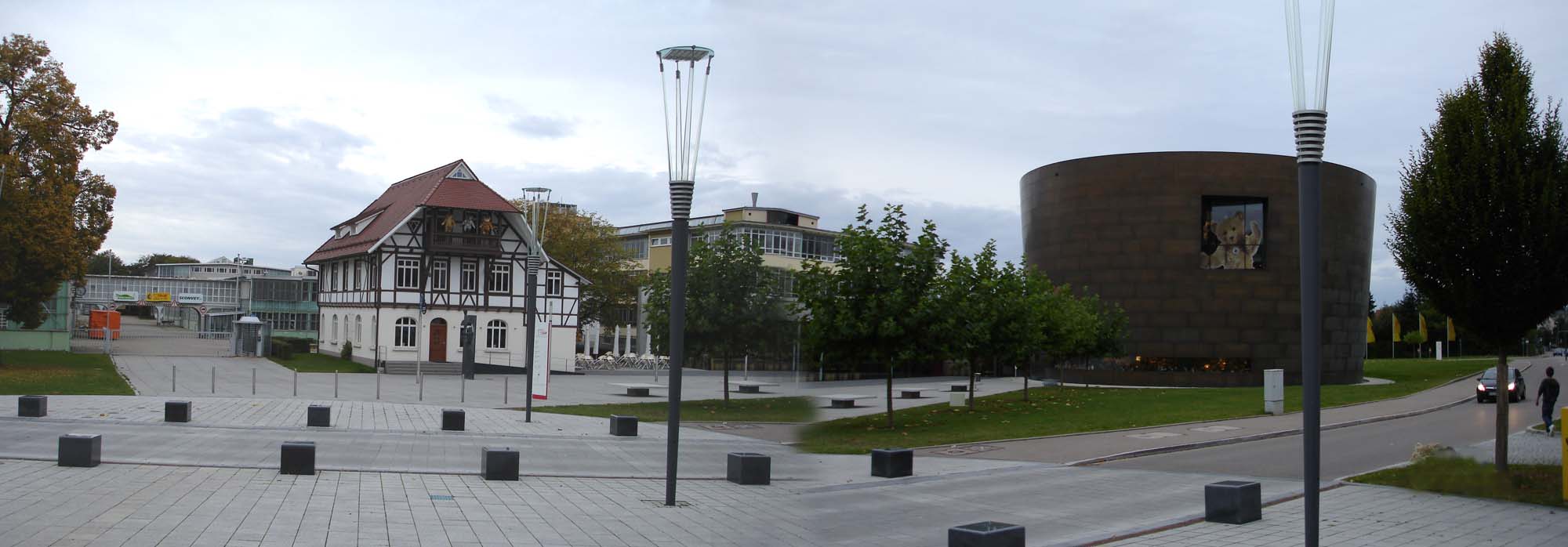Steiff academy
Hesemans at the Steiff Academy
The day started with an early rise. We were expected to be at the Steiff factory, in Giengen, at 09:00. We were welcomed by the export manager of Steiff, Stefan Mühlenbein. The day was themed the Steiff of now and the Steiff of the future. This called for a trip into the past. The saying from the founder, Margarete Steiff, “for our children only the best will do” is the centre point of attention. During this day we got a peek behind the production doors, and a lesson in product knowledge.
The program started with a presentation about what Steiff does differently to the other brands. Almost immediately was discussed how much better the quality and safety is. They, of course, fulfill the requirements from ISO and LGA. They also fulfill all the requirements made by the much stricter T.U.V institution for their staff as well as their product. Not only that but they also with their self applied standards, take a step further and were offered a 10 in the “Öko Tex-standard 100 Class one” for a pure product. ;
1; Steiff avoids using harmful materials in their products. These demands are voluntarily stricter than the official law.
2; Steiff avoids using materials that can cause allergic reactions.
3; Steiff gebruikt bij het kleuren van hun stoffen en de beschildering van hun producten géén schadelijke verfstoffen.
4; Steiff only uses selected materials from companies in Germany or Europe. Meaning they know where the materials originated.
5; Steiff uses for their teddy bears a lint-free surface material from top quality.
6; Steiff only uses safe materials for their teddy bears and stuffed animals.
7; Steiff has higher personal demands, concerning their finish and seams, than the international requirements.
8; Steiff produces their teddy bears and animals according to the principal of durability. “they’re made for generations”.
9; Steiff stands for the hygiene possible for its product, during and after production.
10; Steiff uses independent labs and institutions to evaluate the Steiff hygiene regulations.
To guarantee this they have taken on several different suppliers. From 2010 all products will be made in Germany and all materials will come from Europe.
Just after 10:00 it was time for the more relaxing part of the program. We were allowed to visit the Steiff museum. A wonderful experience for the true fans. Through a moving scene we landed in Margarete Steiff’s world. For a second it seemed as if we really were there. With a giant lift we passed the historical work place of margarete Steiff, into the museum. Here we could walk through a fairy tale like moving décor through the museum. We know these types of decors from our visits to the Neurenbeurg exchange but these were very impressive. Of course there are a lot of old articles and histories to be found in the museum. At the end there was a hall where we could see the production of bears. Colleagues were working right there!
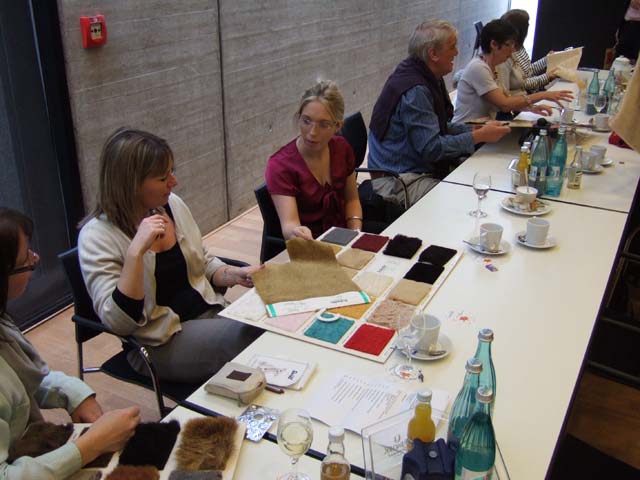
When we got back it was back to work. Material knowledge! The way the different materials felt and looked. Here we also discovered that alpaca is the 30X more expensive than the cheapest material they use, Mohair/silk is just as valuable but slightly cheaper. The alpaca (looks like a llama but is not the same) can only be shaved once every two years.
Just after the lunch break we visited the birth place of Margarete Steiff. The recently restored is not yet livable. It gives a nice impression of her living environment.
After that we went into the factory. The test lab was first on the list. Here they test the strength of both of a teddy bears arms. They reach way above the legal norm, 4X the necessary strength, 284 Newton and Petsy the bear still remained whole!
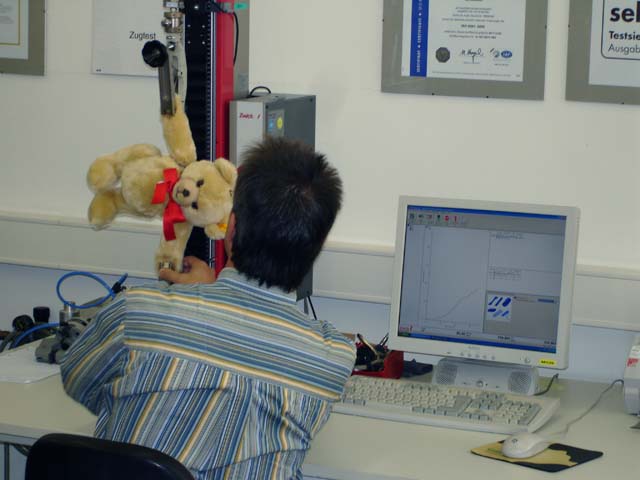
After that they did the lightfastness test. Even in combination with acid from the hands the bears should only be allowed to change color within the norm. They also had the optical white makers do their work. You know it from your own clothing, under a UV lamp your clothes light up purple-y. Steiff does not use this because combined with sweat it can cause an allergic reaction. Of course they also do the burn test. Yes it’s a big maltreatment these tests. Every model from the collection is tested several times a year. In total more than 12000 extra tests. What Steiff has, the only producers which do, is a metal detector and an x-ray machine to check whether there are any things inside the animals which don’t belong there. Safety above everything else!
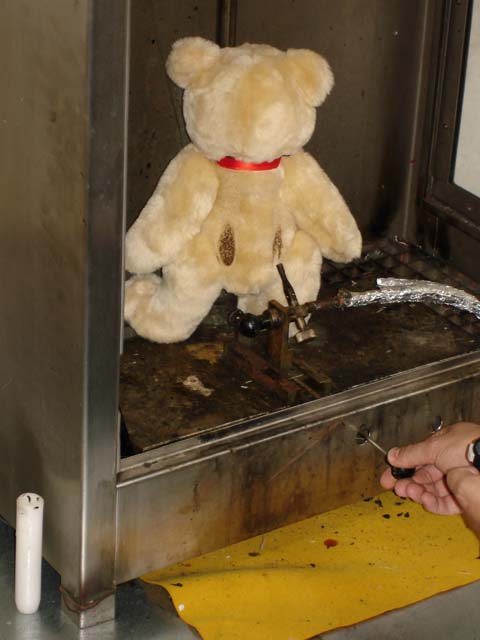 Of course we were also allowed to take a look at the “happier” part of the production. From the designs (for the collection of 2010 we sadly can’t share anything)to the pressing in of the famous ear mark “knopf im Ohr”. And is this button safe? Yes, we tested how easily It tears using a special machine in the labs. But also the pressing in of the button on the ears is computer controlled and the records are kept for years. We end in the storage place for the studio animals. Life-size rabbit, giraffes and elephants.
Of course we were also allowed to take a look at the “happier” part of the production. From the designs (for the collection of 2010 we sadly can’t share anything)to the pressing in of the famous ear mark “knopf im Ohr”. And is this button safe? Yes, we tested how easily It tears using a special machine in the labs. But also the pressing in of the button on the ears is computer controlled and the records are kept for years. We end in the storage place for the studio animals. Life-size rabbit, giraffes and elephants. 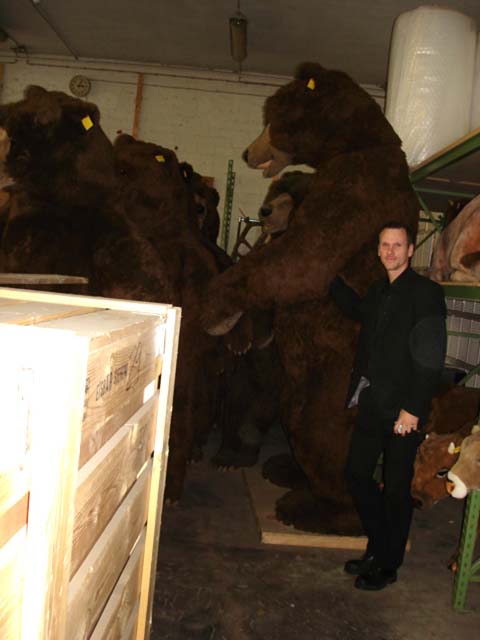 The above written statement is different people a technical story. Regardless we have gotten and impression of the care and love there is for the work. The making of a durable, safe but mostly beautiful stuffed toy that is trusted to a child who can love it and, without a care, share their entire life with it. For the collectors Steiff has mostly designed little pieces of art which deserve a special place in people’s homes. Stefan Mühlenbein had already approached us during the preparation of the Steiff academy and had asked us whether we would come if it were to go ahead. He indicated that we have the same vision in our business as Steiff does in theirs. We love to sell quality products which we fully support. Because of this he really appreciated our showing up. For us it was a real honor to have been able to take part in the Steiff academy and we look back at it with a smile.
The above written statement is different people a technical story. Regardless we have gotten and impression of the care and love there is for the work. The making of a durable, safe but mostly beautiful stuffed toy that is trusted to a child who can love it and, without a care, share their entire life with it. For the collectors Steiff has mostly designed little pieces of art which deserve a special place in people’s homes. Stefan Mühlenbein had already approached us during the preparation of the Steiff academy and had asked us whether we would come if it were to go ahead. He indicated that we have the same vision in our business as Steiff does in theirs. We love to sell quality products which we fully support. Because of this he really appreciated our showing up. For us it was a real honor to have been able to take part in the Steiff academy and we look back at it with a smile.
(c) Maria en Johan Hesemans 12 oktober 2009

 Nederlands
Nederlands
